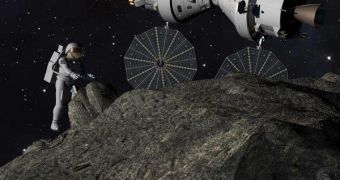A four-month review of the options currently available for the American space agency has revealed that the bill proposed by Senate appears to be the best way to go.
Some key tenets of the proposals US President Barack Obama made a the beginning of this year are unfeasible, the reports further states.
The group that came to this conclusion is made out of various NASA experts, who were tasked with looking into deep space exploration plans, as laid out by Senate and the President.
The end result was that the bill had more chances of becoming reality, and that it was a lot more feasible, time- and hardware-wise, than what Obama had proposed in his 2011 budget request.
The document was recently presented to Charles Bolden, who is the NASA Administrator. He is known for sharing Obama's viewpoint on the need for change. His deputy, Lori Garver, was also briefed.
The President had urged in his proposal that NASA strive to put astronauts on near-Earth Objects (NEO) by no later than 2025, versus the plans to send humans to the Moon again by 2020, as intended under Project Constellation.
But the Human Exploration Framework Team (HEFT) group found that to be unfeasible, and instead tended to agree with the NASA authorization bill voted by Senate in August.
One of the key points that separated Obama's view from that of Senate is when and how a new heavy-lift delivery system should be constructed, Space reports.
While the President said in April that five years and $3 billion will be needed to devise a basic project, the Senate believed that work on such a rocket should begin immediately.
According to HEFT, the American space agency should immediately begin work on a space shuttle-derived heavy-lift rocket, that would be operation by 2015, or around that time.
The team said that there is no imaginable benefit in delaying beginning work on an exploration-class rocket until 2015. This delay would only serve to hamper NASA's operations, and reduce its options.
At this point, no clear decisions have been made as to how the agency should proceed further.
According to NASA officials, Bolden, Garver and the NASA associate administrator for exploration systems, Doug Cooke, have all been briefed on the HEFT findings.
The team also argues that the Orion Crew Exploration Vehicle should also be kept in its current shape, and used for space exploration, rather than be converted into a lifeboat for the International Space Station (ISS).
Mike Griffin, former NASA Administrator under George W. Bush, said on September 9 that Senate should push for creating a rocket capable of carrying at least 130 metric tons to orbit.
He called this ability essential, “if we are to build the technical means for manned journeys to Mars in this century.”

 14 DAY TRIAL //
14 DAY TRIAL //